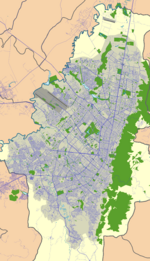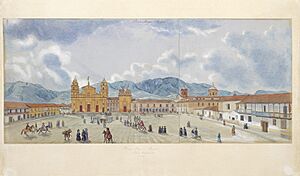Plaza de Bolívar, Bogotá facts for kids
| Plaza Bolívar (Spanish) | |

View of Bolívar Square
|
|
| Former name(s) | Plaza Mayor (1539–1821) Plaza de la Constitución (1821–1846) |
|---|---|
| Namesake | Simón Bolívar |
| Area | 1.3903 ha (3.436 acres) |
| Location | La Candelaria, Bogotá |
| Coordinates | 4°35′53″N 74°4′34″W / 4.59806°N 74.07611°W |
| North | Calle 11 |
| East | Carrera 7 |
| South | Calle 10 |
| West | Carrera 8 |
| Construction | |
| Construction start | 27 April 1539 |
| Inauguration | 20 July 1846 |
| Other | |
| Status | National monument (19 October 1995) |
The Bolívar Square (in Spanish: Plaza de Bolívar) is the most important square in Bogotá, the capital city of Colombia. This famous square was once called Plaza Mayor and later Plaza de la Constitución. It sits right in the middle of the city's oldest area.
In the center of the square, you'll find a statue of Simón Bolívar. He was a very important leader who helped many South American countries gain independence. The statue was made in 1846 by an Italian artist named Pietro Tenerani. It was the first public monument ever placed in Bogotá!
The history of Bolívar Square goes way back to a time before Europeans arrived, when the Muisca Confederation lived there. The first building, a simple church, was built in 1539. This was just one year after Bogotá was founded. During the time when Spain ruled Colombia, Bolívar Square was a busy place. People watched circus shows, bought goods at markets, and even saw bullfights there.
Today, many important buildings surround the square. The Palace of Justice is on the north side. The National Capitol, where the country's laws are made, is on the south. On the east side, you'll see the Primary Cathedral of Bogotá and the Archbishop's Palace. The Liévano Palace, which is Bogotá's city hall, is on the west.
Bolívar Square is a popular spot for tourists in the La Candelaria neighborhood. It's also a place where people gather for important events and peaceful protests.
Contents
Exploring Bolívar Square
Bolívar Square is a large open space. It is bordered by Calle 10 to the south and Calle 11 to the north. Carrera 7 is on its east side, and Carrera 8 is on its west. The square covers an area of about 13,903 square meters (about 3.4 acres).
Important Buildings Around the Square
Many significant buildings stand around Bolívar Square. Each one plays an important role in Colombia's government or history.
| Edge | Building | What it's for | Built | Image |
|---|---|---|---|---|
| North | Palace of Justice | Where the country's highest court works |
|
|
| West | Liévano Palace | Bogotá's City Hall |
|
|
| South | National Capitol | Where the Colombian Congress meets |
|
|
| East | Primary Cathedral of Bogotá | Main church for the Archbishop of Bogotá |
|
A Look at History
Ancient Times: The Muisca People
The story of Bolívar Square begins long before Bogotá was a city. The Muisca lived in this area. They were one of the four great ancient civilizations in the Americas, along with the Inca, Aztec, and Maya. The Muisca were very smart about the sun and moon. They used a special calendar to track the seasons.
They built temples to honor their gods, especially Sué (the Sun) and Chía (the Moon). Experts have studied Muisca astronomy. They found that from the northeast corner of Bolívar Square, the sun rises perfectly over Monserrate mountain during the summer solstice. In winter, it rises over Guadalupe Hill. During the spring and autumn equinoxes, the sun appears between these two mountains in the Eastern Hills.
Spanish Colonial Period
In 1538, a Spanish explorer named Gonzalo Jiménez de Quesada founded Bogotá. This happened after he met the Muisca leader, Tisquesusa. Soon after, other explorers arrived. The Spanish built the first church on the square's northeast corner.
For many years, the square was called Plaza Mayor. It was a central spot for markets and public gatherings. People would watch circus acts and other events there. In 1583, a public water fountain was built, providing fresh water to the city.
Over time, more buildings appeared around the square. Merchants built two-story shops. The Real Audiencia building, for colonial government, was also constructed. In 1604, the Jesuits started a school, the Mayor School of San Bartolomé. The current Primary Cathedral on the east side was started in 1807 and finished in 1823.
The Republic is Born
A very important event happened in a house on the northeast corner of the square. This house is now called the Museum of the 20th July. On July 20, 1810, people made the first big move towards independence from Spain. This moment is known as the Call for Independence.
After Colombia gained independence, the square was renamed Plaza de la Constitución in 1821. It kept this name until 1846, when the statue of Simon Bolívar was placed there. That's when it became Bolívar Square!
The National Capitol building, where the Colombian Congress meets, began construction in 1846. However, due to political changes, it wasn't fully finished until 1926. The beautiful French-style Liévano Palace on the west side was built between 1902 and 1905. Since 1974, it has been the office of the Mayor of Bogotá.
Modern Times and Changes
The Palace of Justice has a dramatic history. The first building, built in 1921, was destroyed by fire in 1948 during a time of unrest in Bogotá. A new palace was built, but it was also destroyed in November 1985 during a difficult event involving a guerrilla group and the Colombian Army. The ruins remained for a few years. Then, in 1989, the government decided to build a third palace. Construction for the current building started in 1998.
Bolívar Square was recognized as a national monument in 1995. This means it's a very important historical site for Colombia.
The square has always been a place for people to express themselves. In 1947, over 100,000 people gathered there to protest. In 2016, students even camped out in the square to make their voices heard. It continues to be a vital public space for the city.
Panoramas
See also
 In Spanish: Plaza de Bolívar para niños
In Spanish: Plaza de Bolívar para niños











